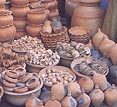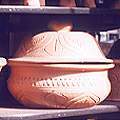
Ceramics, Porcelain, Bone china, Clay, Terracotta, Pottery, Crockery, Cookware, Cutlery
Earthenware of Sri Lanka
The Sinhalese use a great deal of terracotta (and sometimes unbaked clay) products for ceremonial, architectural, and domestic purposes. Though the clay ware is extremely utilitarian in character, yet it is also very charming, with interesting forms and decorative motifs and styles. The pottery used for domestic purposes is often unglazed, and undecorated, whereas that used for decorative purposes is usually coloured, painted, or glazed. Sinhalese pottery displays characteristics that are indicative of adept and skilled workmanship. The Sinhalese potters or badahelayo are usually found clustered in areas where suitable clay is available in abundance.
Glazing of pottery was uncommon in ancient times in Sri Lanka, though primitive glazes did exist to make the pottery less porous and to enhance the appearance; today, it is found mainly in pottery intended for decorative purposes. Elaborate terracotta and clay-ware was earlier made for religious purposes, and royalty and rich patrons utilised the services of the best clay artisans for custom-made products. Terracotta, in Sri Lanka, is one of the crafts that has not degenerated over time, owing to the fact that it is inexpensive and well adapted to local requirements as also that it has not suffered from competition with machine-made wares.
The use of moulds in pottery shows links between pottery and metal-casting. Metal-craft and pottery have grown alongside each other in Sri Lanka right from the Anuradhapura period.
The key requirements that a vessel must possess a shape attuned to the purpose for which it is intended – and that the shape must evolve naturally from the method used to make the clay object and should enhance the plastic properties of clay without becoming weak and fanciful – seem to be engrained in the pottery and earthen-ware in Sri Lanka. It is also important that the shape and aesthetics of the clay/earthen-ware object should not interfere with the utility of that object, but should be linked in character and design with the purpose for which the vessel is intended and the material it is made of. The product made should not possess elaborate refinements and designing if it is meant for ordinary daily use, especially if these interfere with the intended use of the object
HISTORY: THE THREAD OF CONTINUITY
Pottery has a long and unbroken tradition in Sri Lanka, and the potter, as an artisan creating both utilitarian and decorative items, seems to have a niche that has continued through the centuries in Sri Lanka. Archaeological excavations in various parts of the Dry Zone in the country have revealed various types of pottery used in the proto-historical period. The pottery unearthed from Pomparippu in 1970, is chiefly a coarse pottery made of sand and grit, with the black and red variety produced by the inverted firing process being found along with incised-work and finger-tip work. Excavations at Gedige (Anuradhapura) and Kandarodai (Jaffna) have established the wide use of pottery items in the early stages of the island’s history. Some of these findings attest to the wide use of pottery much before the period of recorded history.

These conclusions are furthered by the excavations carried out at Jetavanarama and Abhayagiri under the UNESCO-Sri Lanka Cultural Triangle Project, which has yielded evidence of earthen-ware and ceramic products. With trade activities very active between Sri Lanka, India, and China, Indian and Chinese techniques found their way into Sri Lanka. Mahavamsa – a historical treatise on Sri Lanka, also known as the Great Chronicle, written in the Pali language in the fifth century A.D. in the reign of the King Dhatusena and translated by E.M. Coomaraswamy in the year 1907- refers to potters as uluwaduwo, that is, those who used different varieties of clay, and using a wide range of techniques, made strong and durable terracotta products. The Mahavamsa is based on the historical material contained in the Sinhalese atthakathas or story-based theatre and other legends and traditions prevalent amongst the people of the time. It covers the period 543-301 B.C with continuations and supplements added until the time of Kandyan occupation by the British in the year 1815.
According to the Alahana Parivena Project of the Cultural Triangle at Polonnaruwa, terracotta-making seems to have been a prolific craft in the ‘Polonnaruwa’ historical period (roughly between the eighth and the seventeenth centuries A.D.), which followed the ‘Anuradhapura’ period (roughly between 161 B.C. and the eighth century A.D.) There seemed to have existed a rich folk-art tradition that influenced the making of a lot of terracotta products like statuettes of gods and of cult objects, including phallic symbols, using the solid casting technique. There seems to have been a fair amount of creative experimentation in the folk-art tradition; the artisans in the rural areas seem to have been unencumbered by any set codes or rules. Existing inscriptions, referring to historical records of Anuradhapura, mention that potters at Kumbal ‘had to work in their sheds and produce the pots and utensils required by the community in the village’.
Since there was no real paucity of raw material, the traditions of pottery craft have continued without interruption. In the Kandyan period (between the seventeenth and the nineteenth centuries A.D.), terracotta and clay-workers received recognition from both the royalty and the nobility. Potters, as craftspersons, were given both social status and respectability. Some of the genealogical names indicating this craft are Panditayalage, Panditage, and Pandita denoting both ‘wisdom’ and ‘a wise person’.
In ancient times, every affluent manor-house had – along with metal craftsmen and other artisans – a potter attached to it to serve the needs of the house The royalty, of course, had all types of artisans hailing from various caste-groups to serve their needs. The products made by terracotta artisans included tiles, bricks, and terracotta vessels. The potters also worked for themselves and their neighbours, for which they received payment in kind or as money.
THE RAW MATERIALS
The three main types of clay used are earthen-ware clay, kaolin or white clay, and ball clay.
- Earthen-ware clay is the common red clay, usually mixed with sand and grit, used mainly used for making bricks and tiles; dirt-free layers of this clay are used for pottery.
- White clay occurs in the form of large deposits; it cannot be used by itself and is combined with other materials to be used for pottery. It is known as China clay and is used in the manufacture of porcelain and ceramics.
- Ball clay occurs as small deposits and is mixed with kaolin to form the clay body and the adjusted mixture is used to make china-ware.
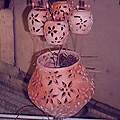
The earthen-ware clay required for cut work, and incised and painted pottery is usually obtained from Nattandiya, while ball clay is obtained from Dediyawela, and white clay or kaolin is from Boralesgamuwa and Meetiyagoda. Even though clay-workers continue to be found in close-knit groups in the villages where the types of clay suitable to their craft can be found, yet owing to the widespread demand for traditional household utility-ware, those artisans who make household items are found scattered in almost all the districts in the island. Hence, the issue of transportation of the clay from the rich clay fields of Hambantota and Puttalam districts does pose a problem because of the absence of proper access roads. Clay has to be carried by head-loads, which increases its cost; moreover the fact that clay workers have to travel to remote areas to collect the clay this automatically leads to an increase in the cost of production. Also, in the rainy season it is not possible to mine clay from the tanks and hence the artisans are forced to stop their work.
Clay, mixed with other materials, is used to create earthen-ware, stone-ware, and porcelain. Earthen-ware is the least expensive and needs to be glazed if it is to hold liquids, while stone-ware has a very hard and strong texture – comparable to a glassy surface – and is able to hold liquids without glazing. The products made from this type of body include wall tiles and floor tiles. Porcelain is the most refined type of pottery and is made from a mixture of kaolin, quartz, and feldspar, fired twice and glazed; it is also known as china-ware.
FORMS & TECHNIQUES
1. STANDARD PROCEDURES
The potter who makes pottery products for domestic use has not deviated far from the traditional methods used by his ancestors over time. The two types of clay mixed in equal proportion are the red clay, which has a bit of sand, and black clay. These are mixed thoroughly and heaped up and left aside for about a month for seasoning. The heap is then broken and sliced with a sliver of bamboo to remove grit, dirt, and roots. After adding a suitable quantity of water, the clay is kneaded by being tread upon and trampled. The heap of clay is then covered with cadjan fronds and allowed to remain for a day after which the throwing of the pots on the wheel is done.
The primitive saka poruwa or wheel is about 2.5 feet in diameter. It is mounted on a central stone pivot which fits into a larger stone socket that is firmly fixed on the ground. The wheel is turned by the potter’s wife or child. The potter takes a ball of clay puts it on the centre of the turning wheel and does the moulding with both hands; the form and mouth of the vessel is shaped. Each pot is cut off from the wheel after shaping by a spoke or an ekel. The rim of the pot is finished using a piece of rubber tubing or a wet-cloth. The bottom of the pot is left open to be done later; the trimming and shaping of the pots is done after this. After a gap of a day, the potter takes a smooth stone in his left hand and the valantalana lella or metialuwa, a wooden bat-shaped implement, in his right hand. He holds the stone inside the vessel and pats its sides till they finally meet across the bottom. The vessel is then rubbed smooth with a bat; any decorative pattern is now added and the vessel is allowed to dry slowly in the shade before firing.
Firing is done in a kiln made by the potter himself. This is a square enclosure built with bricks up to a height of about 3 to 4 feet with a domed covering of wet clay and sticks. It has three or four openings on one side for the insertion of firewood and on the opposite side there are smaller openings for the smoke to escape. Once the pots are packed inside the kiln, the firing is done gradually. Easily available fuel material, like coconut-husks, is used. The stock is first smoked with coconut-husks for about two days; this process is known as dungahanawa. After this, firewood is inserted into the openings and the actual firing begins. The temperature is increased gradually by inserting more and more firewood. After firing for about 24 hours, the fire is put out and the kiln is allowed to cool down, after which it is broken up. Proper loading of the kiln, along with proper firing, as well as maintaining uniform temperatures at the required times are necessary to minimise cracking and breakages. Nowadays foot-operated wheels are used to make the whole process simpler.

2. GLAZING
Glazing not only allows the object to become non-porous but also greatly enhances the appearance. Traditional forms of glazing involve coating the object with the glaze by dipping, brushing, pouring, or spraying it, after which the coated item is fired. The glaze melts and forms an even glassy coating on the pottery. Glazed pottery-ware is usually made with either red or black clay; glazing as a process has evolved through the introduction of new techniques.
3. PAINTED POTTERY
This is a very ancient craft that has nearly become extinct today in Sri Lanka. The painting on the piece of pottery is done by hand. The colours used are those common in Kandyan art-work – red, yellow, black, and white (the colours were derived from natural sources as described in slip-painting). In contemporary work, normal oil-based paints are used. The motifs and designs are traditional, and often identical with those found in other forms of paintings such as book-covers and wood-work.
Slip Painting
This involves the application of concentric bands of red on the vessel, which is kept inverted on the wheel and revolved slowly as the brush is held against it. The red paint is obtained by grinding a mixture of ferruginous nodules with concretions, the white paint is obtained from kaolin, and the black paint is from graphite. The ornamentation also involves painting geometric designs in red or white on the pots.
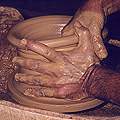
4. INCISED POTTERY
This method of decorating pottery has been practised since ancient times and is used even today to decorate domestic utility items. The incising is done before firing and the pot is allowed to dry. When the pot is partially dry, red gurugal paint – made by grinding certain ferruginous nodules and concretions and mixing it with water – is applied over the part where the incising is to be done. The painting is done on the wheel; when the coat of paint is partially dry, then the incising is carefully done on the layer of red paint with a pointed instrument.
The uppermost band of incised ornamentation has mainly geometric designs, the middle band a conventional branch or vine (vela) and the lowest band usually has designs of fish, alternating with a sort of a inverted trident. Below this are a few upright lines in widely separated groups. The vessel is then fired, after which the design appears brighter against the brown colour of the rest of the vessel. The design is then filled in with kaolin or white paint. This method of embellishing pottery is found mainly at Kelaniya and is used both for traditional vessels as well as for articles such as spice containers, fruit bowls and dinner sets; a large variety of animals, toys, and money boxes, among other products, are also made using this method.
The nembili – a vessel where the furrowings are incised inside this utility-vessel and the arrangement of the grooves is elegant and decorative – are made using this method. Tiles, mainly the semi-cylindrical ridge tiles are also incised using this method.
The chief tools and equipment required for incised pottery include the soka-poruwa or potter’s wheel; the walantalanalella, which is used to tap the pot into shape; the kiln to fire the pots; and the irigahana katuwa to draw the design. There is also a need for a piece of wire to cut off the pot from the wheel.
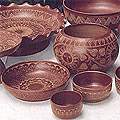
5. STAMPED POTTERY
This was common in the past; however the technique of stamping pottery is not very common now. The traditional method involves stamping the vessel around its mouth. The stamp, made of wood or metal, is called achchuwa. The design(s) with which the pottery is stamped include rosettes, simple lines, and bo leaves. The bo leaf motif is a constant in almost all Kandyan pottery. Occasionally, finger-mark decoration is done on vessels; this is seen even in modern flower-pots. The finger decorations are done before firing.
6. CUT-WORK POTTERY
This is a recent innovation in ornamenting pottery and has been developed by the Department of Rural Development and Cottage Industries. It is used mainly in decorating terracotta lamp-shades. A special variety of clay found at Dediyawela in Kalutara district is used. This clay is mixed with welimetta, a clay containing about 35 per cent sand. This is mixed thoroughly and then powdered and dried. This mixture is dissolved in water and strained into another vessel after adding a little silicate to the mixture.
This liquid is kept for a day before being poured into the mould of the article to be made. After about an hour and a half hour, the mould is removed and the article is allowed to dry in the shade; after about 24 hours, when the object is only partially dry, the cutting of the design begins. A sharp tool like a thin bladed knife is used for the cutting and after this the product is fired. To prevent damage during the firing process, the lamp-shades are packed in clay-containers called sagger before placing them in the kiln. The preference nowadays is for an off-white colour, obtained naturally after firing; however, if so desired, the shades are coated with a layer of white paint after firing. Cut-work pottery requires moulds of different designs and sharp tools for cutting the design.
7. CERAMICS
Derived from the Greek ‘keramos’, giving the sense of ‘potter’s earth or earthen’, the term ceramics is, at present, used to describe an ‘extensive range of man-made articles using a mixture of earth, rocks and minerals, finally converted into stable and hard objects by heat’. Ceramics has received considerable government support in Sri Lanka and has developed substantially. Ceramic-ware comprises of porcelain and crockery and this field has reached a stage of self-sufficiency setting high standards in quality and design. Though the process involves some mechanisation, manual skills are used for processing materials, moulding designs, and glazing and painting of the finished products. Common ceramic-ware products include vases, dishes, trays, flower-pots, figurines, statues, candle-stands, lamp-shades, souvenirs, tea containers, kitchen-ware and table-ware in dainty and captivating designs.
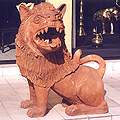
THE PRODUCT RANGE
The generic terms for pots in Sinhalese are heliya, kalasa, and walanda.
1. HOUSEHOLD & RITUALISTIC ITEMS
General Forms
- Kalagediya: The kalagediya is a water-carrying vessel, almost spherical in shape, which is found in every household. Other ‘pots’ are more shallow.
- Muttiya: The muttiya is a wide-mouthed vessel, traditionally used for boiling rice. Pots used for collecting syrups and storing medicinal juices are known as uga mutti and embul mutti.
- Apalla: Apalla is the generic term for shallow vessels used for cooking rice in. The larger vessels are known as loku appalla and the smaller ones as appalla podi.
- Etili: The etili are shallow pots used for cooking curries, while the broad shallow pans used for cooking sweetmeats are known as kanbola etiliya.
Specific Products
- Batvalanda: The batvalanda is a shallow vessel with a ring foot that is used to eat rice from. Unlike the nembiliya, it has no internal furrowing.
- Bummediya: The bummediya is again a vessel open at both the sides, in which the larger opening is covered with a talagoya skin attached with a paste made from rice and banana, and this drum is used at harvest times.
- Dummala Kabal: Earthen incense burners with very elegant forms are known as dummala kabal.
- Gini Kabala: The gini kabala or the fire dish provides fire for the goldsmith’s blowpipe.
- Gurulettu: The gurulettu is a narrow-necked water-vessel.
- Heliya: Containers to store clothes in are known as heliya, with piti-heliya denoting the larger size and halu-heliya the smaller size. Clothes are better protected in these containers from white ants than when stored in wooden boxes.
- Halamba Heliya/ Nayi Heliya/ Bulat Heliya: Wide-mouthed vessels with moulded cobra motifs found in temples dedicated to the female goddesses are called halamba heliya or nayi heliya; when they are without the cobra motifs they are used to hold betel leaves and are known as bulat heliya.
- Koraha: The koraha is a vessel that stands with the help of a ring foot. The pol koraha is used for washing and the vil koraha for soaking seed paddy.
- Kalaha / Kalasa / Kalaya: The kalaha or kalasa or kalaya is a kind of vase open at both ends which is used to keep sprays of coconut flowers during auspicious and ceremonial occasions.
- Kotalaya: The kotalaya is a spouted vessel used in the temples to sprinkle water on the flower offerings.
- Lipa: The lipa is a low cylindrical earthen stand used to raise the level of the cooking pot above the fire on the ground.
- Meti Pahan: Earthen lamps used in temples are small plain shallow dishes called meti pahan.
- Meti Pandama: The meti pandama is an earthen cresset filled with tow and oil and when lit is carried in processions.
- Nembiliya: The nembiliya, vessels used for washing rice, are shallow dishes with the rim projecting inside, and are covered with elegant arrangements of deep furrows all over.
- Padikkam: Earthen spittoons are known as Padikkam.
- Pakuru: One-handled mugs are called Pakuru.
- Patras: Very large wide-mouthed earthen vessels are known as patras. They are used to hold water or receive offerings of rice at the temples. They have very simple lines and the decorations are also minimal with the religious Bo leaves in red on their surface.
- Pin Taliya: The pin taliya is a wide-mouthed vessel filled with water for the travellers.
- Pornuva: The pornuva is a three-legged vessel used as an oven as it retains heat very well.
2. TILES & ARCHITECTURAL ITEMS
Terracotta tiles – both flat ones with designs of parallel incised lines and semi-cylindrical roofing tiles, which taper upwards slightly – are made, as are eaves tiles, which are used on the roofs of temples and mansions to fringe the eaves. These tiles have a plain flat upper portion that passes under the last row of tiles at the edge of the roof; the other part hangs, forming the roof-fringe, and this part is either square or in the shape of bo leaves. Designs of the lion or simha and the goose or hamsa are often embossed on the surface. The same designs are also found on rectangular tiles that are used for the decoration of wall surfaces. Some of these tiles are even painted. These are seen mainly in Kandy district, especially in the Temple of the Tooth Relic.
3. DECORATIVE PRODUCTS
Terracotta artisans in contemporary Sri Lanka create a large range of decorative pieces, in addition to the more traditional religious and domestic utilitarian pottery that is still widely used in the island nation. A number of artisans, all of whom have mastered the techniques, tap their own creativity and make use of their skills by producing terracotta products that are fascinating in purely aesthetic terms. While some of these products – in particular decorative heraldic animals and birds along with a variety of garden ornaments – are just for display, others combine utilitarianism with remarkable aesthetics. A striking example of the latter is the table-ware made for the urban market – a range of goblets, bowls, and fruit stands, as well as a particularly elegant table-ware in red clay with intricate designs.
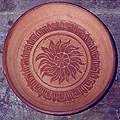
MOTIFS & DESIGNS
1. ANIMAL FORMS
Animal forms, both natural as well as culled from mythology and folk-tradition are present, with a few motifs being repeated frequently. The hamsa (goose) is a divine bird in Hindu mythology that is found widely in early sculptures of Sinhala art. It is also commonly found in contemporary terracotta and clay-ware products, linking a tradition with the Gampola and Kandyan historical periods when it was found abundantly, and some argue, for the first time. The cobra or naga motif is mainly found in its natural form in clay products, although there are decorative products where it is found in its mythical variations. These include the naga poruwa or a whorl of interlocked cobras, the naga dangaya, and the naga darana (elaborate entwining of two cobras). The mythical fish or matsya is said to be a reincarnation of Lord Vishnu; it is found as a decorative motif in terracotta and it is used to symbolically represent water.
2. FLORAL DESIGNS
The liyawela is a motif whose name is supposed to be derived from the graceful sinuousness of the female form, which it is said to embody. This motif is composed of leaves, branches, flowers, buds, and tendrils, which trail from the sinuous creeper and form a symmetrical pattern; when two such creepers are drawn intertwining with unvarying uniformity they form a graceful design. They are sometimes found in combination with a central motif, often depicting a bird, either mythical or natural. The flower and leaf patterns found in this motif are not conventional in nature.
Ananda K Coomaraswamy describes pottery from Kelaniya (a typical piece of Kelaniya pottery is a highly-finished water vessel or kalagedi) as one in which ‘incised decoration reaches its highest level of design and execution’. The decorative form of the pineapple flower – annasi mala – is used to a great extent in terracotta and clay-ware; the contemporary depictions are more elaborate in form than the earlier designs. The nelum mala or the lotus flower motif is found in all kinds of Sri Lankan handicrafts, especially in the early sculptures and paintings; it is usually set in a geometrical form within a circle. In the Kandyan period of Sri Lankan history, pottery items were decorated with lotus flower rosettes. In the incised pottery found at Kelaniya, line drawings of the lotus flower can be found.
The religious bo leaf (Ficus religiosa) is a traditional Sinhalese motif; it is present in several form and variants in terracotta and clay-ware. Bo pat kangul represents the bo leaf alternating with a dart, and is mainly used as a border design.
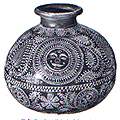
3. GEOMETRICAL DESIGNS
A geometrical design known as the bindu vela – a row of small circles and dots found within two parallel lines – is mainly used as a border design around a central larger motif. Another geometrical design used in terracotta and clay products is lanuwa, which is usually of two types, the eka-pota lanuwa or one-ply plait design and the depota lanuwa or the chequerwork or grass matting design).
PRACTITIONERS & LOCATIONS
The alluvial clays of Sri Lanka are found in the flood plains of major river systems. These deposits from rivers are the basis of the growth of the pottery industry in the villages of Kelaniya, Alawwa, and Kurunegala which sustain a growing population practising this craft.
There are certain villages in Sri Lanka that are particularly well known for pottery and for specific terracotta products; here the skills have passed on through generations over hundreds of years. In areas like Kumbalgama in Matara district (which is about 310 kilometres from Colombo) and Kumbalwella in Galle district (about 150 kilometres from Colombo and Badalgama), the village names are patently associated with the craft. Kumbalgama is known for its varieties of domestic pottery, while Kelaniya’s potters are known for their red-ware with incised work used for domestic needs as well as for the colourful clay toys that thrilled children of a bygone age. The potters of Kegalle and Veyangoda, areas that are not too far from Colombo, are well-known for large pots, stands, bowls, and tall vases, which suit the tastes of sophisticated buyers and which are used to decorate houses and buildings.
Caste distinctions were very distinct in the past with regard to the practice of a craft; however, these are becoming less rigid and artisans engage themselves in crafts of their choice without regard to such restrictions. The artisans are found in pockets throughout the island depending on factors such as access to raw materials, availability of organisations for imparting instructions to artisans, the enthusiasm and initiative of welfare organisations, the desire for supplementary sources of income and other factors.
Some centres of clay-ware and terracotta-ware include:
- Ampara district: The villages of Uhana, Tirukkovil, Kalmunai, and Akaraipattu.
- Anuradhapura district ( about 270 kilometres from Colombo): The villages of Kanduruwegama, Kudakelegama, Etawetunuwewa, Elappankulama, Panditarambewa, Katupota, and Lunnewa.
- Badulla district: The village of Dehigolla.
- Batticaloa district (about 365 kilometres from Colombo): The villages of Valaichenai, Eravur, Naripputhoddam, Meeraoddai, and Porativu.
- Gampaha district: The villages of Hunumulla, Kadawata, Nittambuwa, Veyangoda, Weerangula, Ambalamulla, Dalupitiya, Yakkala, Biyagama, and Hansagiriya.
- Hambantota district (at the southernmost part of the island): The villages of Palapota, Nakalugamuwa, Udukiriwila, Pahalagoda, Welandagoda, Angunakola, Gannoruwa, Puwakdandawa, Owilana, Hingurumulana, Kohomporuwa, Ranna, and Yodakandiya.
- Jaffna district (northern-most Sri Lanka): The villages of Chankanam, Point Pedro, and Thumpalai South.
- Kalutara district: The villages of Dediyawala, Anguruwatota, and Polgampola.
- Kandy district (the central province of the country): The villages of Wewere, Maravanagoda, Ratmale, Naranwita, Maharavela, and Walala.
- Kegalle district (neighbouring Colombo district): At Molagoda, Duldeniya, Bellapana, Ambepussa, and Kirapane.
- Kilinochchi district (south of Jaffna): Vaddakachcheri and Pooneriyan villages.
- Kurunegala district (about 125 kilometres from Colombo): The villages of Udaragama, Werahena, Ambahira, Yahalagedera, Danwella, Poramadala, Beddegama and Kehelpatanga.
- Mannar district (on the north-western coast): The village of Murunkan.
- Matara district(southern-most tip of the island; next to Hambantota district): The villages of Kamburugamuwa, Walgama, Ratmale, Yatiyana, Weligama North, Weligama, Kumbalgama (as previously mentioned), Walasgala, and Kapparatota.
- Moneragala district: The village of Obbegoda.
- Mullaitivu district (on the north-eastern coast): Mullaitivu town.
- Puttalam district (on the western coast): The villages of Sengaloya, Kiriwelkele, Tambarakele, Boralessa, Merawala, Kumaragama, Peramkuttuwa, Kirimetiyana East, Werellakelewatte, Thoppuwa, Mahawewa, Wadakkarawewa, and Paramapulla.
- Ratanapura district (at a distance of 215 kilometres from Colombo): The villages of Daamahana and Dumbara.
- Vavuniya district (in the northern belt of the island).
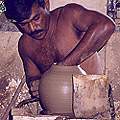
DISAPPEARING TRADITIONS?
THE CLAY SCULPTURES OF BALI RITUALS
These are clay sculptures that are painted and used in performing ancient folk rituals. The Bali sculptures are hand-crafted, and are a wonderful exposition of the skills of the clay artisans brought up in the traditions of folk religion. It represents a craft activity that is entirely indigenous, based on materials and skills available in the villages.
The Bali figures – brightly painted, moulded clay figures – are accompanied by mythical symbols and designs and a wooden platter on which coconut leaves and plantain pith are arranged. The figures are made only of purified clay, and are ritually cleansed and blessed; they are supposed to have magical healing properties and the power to ward off malefic planetary effects.
Life-size figures of planetary forces to be appeased are moulded in low-relief and painted; only occasionally were the sculptures done in high relief. The sculptures are ornamented with the figures of gods and of mythical beings representing the planets, the sun, and the moon. The moulding is created in unbaked clay that is collected with care and cleaned. A coating of kaolin is given before the final painting. Local pigments sourced from plants and minerals gathered from sites in and around the village are used for painting the figures.
The figures and the rituals surrounding them are an interesting amalgam of craft forms like moulding and sculpting, as well as of traditions of exorcism and ritual healing prevalent in ancient Sri Lanka. The artists were guided by the verses on image-making, Ambum Kavi, which they had to memorise; they also had to be able to visualise the image in its completed form before making it. The Bali sculptures, however, reflect a bygone folk art tradition; they are not commonly found in the villages anymore.
The skills of the Bali artisan are comparable with those of an image-making craftsperson. A Bali artisan presents in low-relief what a traditional painter would depict on the walls and ceiling of temples. In today’s times, the Bali artisan can use his traditional skills for clay moulding to make either terracotta or ceramic sculptures or ornamental pottery-ware, all of which would serve contemporary needs, create a means of livelihood, and also ensure that this talent does not fade out.
A CONTEMPORARY PERSPECTIVE
1. ISSUES & PROBLEMS
Potters have a specific set of problems that hinder them in their work; sometimes they are unable to get clay of the required quality, while at other times they find it difficult to get a good market for their products. The old practice of carrying pingo-loads of terracotta and clay products to the market-place continues, thus causing distance to become a serious limitation in determining markets for products. In urban areas, the maximum sales still happen through an unstructured process, chiefly through fairs and exhibitions, where sales are erratic, and depend on the display and variety of products, and where the demand is thus difficult to anticipate. Households in rural areas purchase new terracotta products and clay-ware during festive occasions and in the New Year.
Owing to the introduction of newer modes of production and techniques, there have been a lot of developments and, as a result, the demand for the variety of pottery has increased. The traditional hand-wheels on which the clay is thrown have been replaced, to a large extent, by the kick-wheels; however, the hand-wheel has not altogether been discarded.
2. TO GROWTH
The basis for the growth of this craft has been the continued effort made by individual potters and potters’ societies, along with the interest evinced by the government, which has, through various institutions and departments, initiated and introduced avenues for improvement in and advancement of various aspects of the craft.
Some of the government-institutions involved in promoting the craft are the Department of Co-operative Development (DCD) and the Department of Small Industries (DSI). The Ministry of Rural Development is contributing a lot to the advancement of the pottery and ceramic industries. The DSI operates pottery centres all over the country and has been instrumental in improving both craft skills and product quality by fulfilling requirements related to raw material as well as by providing access to modern, high-temperature kilns for firing the pottery. Waragoda in Kelaniya district has a Design Unit and Research Laboratory for pottery.
The Sri Lanka Handicrafts Board also provides facilities for craftspersons not only to acquire training and develop their skill, but equally to improve on and enhance traditional methods and existing techniques and skills. Techniques for cut-work and ornamental pottery have been introduced and extra kilns have been provided. The National Crafts Council, the apex body that looks after the needs of the handicrafts sector has many programmes that support pottery; there is a Master Craftsman Training Scheme instituted by it, whereby selected master craftsmen teach pottery skills to apprentices.
The Sri Lanka National Design Centre is involved in the enhancement of design, product quality, and craft skills. With assistance from foreign agencies and consultants, the Design Centre has organised workshops for potters to help improve both design skill and quality of products. One of the key efforts of the Design Centre is a project aiming to improve kilns in order to allow products to be fired at extremely high temperatures. The Centre has helped improve the efficacy of ceramic kilns and has introduced new tools and equipment. It has also provided for a gas-kiln at the Veyangoda Pottery Centre and a multi-chamber kiln working on firewood at Molagoda (Kegalle). The centre has created opportunities for training and guidance on the preparation of clay body mixtures and glazes.
3. CONCLUSION
Pottery, originating as a humble craft amidst village based artisans, has taken rapid strides in development due to enormous government and entrepreneurial support. Craftsmanship and competitive skills have contributed to the advancement in the pottery and ceramic-ware. Training of the artisans in government centres in improvements of techniques and designs have improved economic prospects; these training programmes are usually conducted with foreign collaboration.
Earthen-ware artisans, while continuing with valued traditions and preserving the skills of making hand-crafted pottery, now also use new techniques, a combination that attracts buyers and expands the markets. The rustic freshness of earthen-ware is combined with an elegance of design and form to make ornamental and utility items. Technology plays a key-role in the elevation of this craft by aiding in the adaptation and development of human (traditional and innovative skills) and natural resources.
Gallery
YOUR VIEWS
PRACTITIONERS: INDIA
Access 70,000+ practitioners in 2500+ crafts across India.
BIBLIOGRAPHY
10,000+ listings on arts, crafts, design, heritage, culture etc.
GLOSSARY
Rich and often unfamiliar vocabulary of crafts and textiles.
SHOP at India InCH
Needs to be written.




